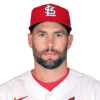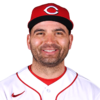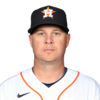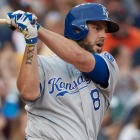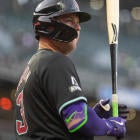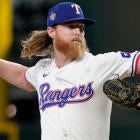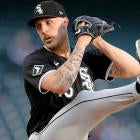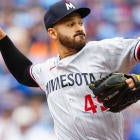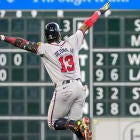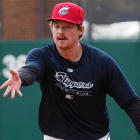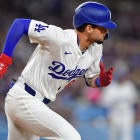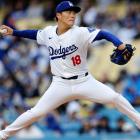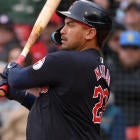There's bold, and then there's bold.
And then there's me: Mr. Tepid.

But I know what day it is. I see you, internet. Your hot takery. Your click baitery.
I can play that game, too, you know.
And what's bolder than predicting next season before this season even ends?
I'll tell you: nothing. It's the boldest thing I've ever seen. I'm boldly going where no man has gone before.
And I'm doing it in boldface text.
These aren't for the faint of heart. They're not for the sound of mind or body. They're not for your dad, your next-door neighbor or even you. They're for me, so that I can point back and say "ha-ha!" if I even manage to get one right.
This is the manner of the bold, of which I'm now one. And if you expand your mind to the place where the plausible is indeed possible, together we can make two.
Behold the bold:
1. Miguel Cabrera reminds us that 35 isn't so old
His 2017 looks like an obvious case of decline until you examine the quality of the contact. According to FanGraphs, he has rarely hit the ball harder and never with more line drives than this year, ranking in the top 10 in both categories. And while there's some speculation that the batted-ball data at Comerica Park hasn't been the most accurate this year, it's at least accurate enough to tell us that the numbers don't support the narrative. Given his history of playing through injury, I'm thinking Cabrera's struggles are health-related, and an offseason of rest will do him the same good it did Bryce Harper a year ago.
2. Rhys Hoskins muscles his way into the top five at first base
Impossible? Nay, improbable. But the bold don't sweat things like probabilities. They follow their gut, and my gut tells me we've stumbled upon a right-handed-hitting Anthony Rizzo here. My one hesitation coming into 2017 was that Hoskins' 38 home runs, second-most in the minors in 2016, came at the notoriously hitter-friendly Double-A Reading, but he eliminated that concern within a month at Triple-A Lehigh Valley this year, revealing himself to be an elite power hitter with uncommon plate discipline -- i.e., exactly what we've seen over his first three weeks in the majors. So why did the prospect hounds universally undervalue him? It tends to happen with lumbering first baseman. Paul Goldschmidt flew under the radar, too.
Plus, with Edwin Encarnacion and Miguel Cabrera taking a step back this year, there's no obvious choice to round out the top five at first base:
| 1 |
Paul Goldschmidt
Arizona Diamondbacks 1B
|
| 2 |
Joey Votto
Cincinnati Reds 1B
|
| 3 |
Anthony Rizzo
Chicago Cubs 1B
|
| 4 |
Freddie Freeman
Atlanta Braves 1B
|
| 5 | ?????????????????????? |
3. J.D. Martinez waits around for a better deal all offseason before finally settling for a budget-friendly three-year deal, a la Edwin Encarnacion ... and then performs like a top-12 outfielder again
If last offseason taught us anything, it's that the juiced ball era isn't the best time to be a bat-first corner man. By now, the 30-year-old Martinez has a steady track record of middle-of-the-order production, but it's not quite Encarnacion's, who may have been four years older when he signed with Cleveland last offseason but was also coming off a five-year run as arguably one of the 10 best hitters in the game. Thing is Martinez is still getting better, putting together what would be a top-10 OPS this year if he had the at-bats to qualify. Someone will be getting a bargain.
4. Tommy Pham ranks just behind him
Yeah, even more underappreciated than Martinez is Pham, who didn't show up until May but has averaged the 15th-most Head-to-Head points per game among all outfielders with a reasonable number of at-bats. But isn't projecting improvement for an out-of-nowhere 30-year-old, you know, reckless? I'd call it bold, but that's partly because I wouldn't necessarily describe Pham as out-of-nowhere. His athleticism was evident even as a teenager, but he was slowed by injuries and, just last year, a vision problem.
The athleticism of course shows up in the home runs and stolen bases, but the growth is most evident in the walk rate. Even while enduring one of his coldest stretches of the season -- a 31-game period that dates back to July 24 -- Pham has reached base at a .395 clip. He excels in so many ways that his floor now may be even more notable than his ceiling.
5. Joey Gallo spends half the season "retooling his swing" in the minors
The 23-year-old is second among qualifying batters with a 37.1 strikeout rate. Only eight others are higher than 30. He leads all qualifying batters with a 58 percent fly-ball rate. Only two others are higher than 50. So not only does he have trouble putting the ball in play but he also makes the type of contact least likely to result in a hit when he does. The expected batting average for a player who strikes out that much and is condemned to a low-.200s BABIP (like he has now) is minuscule, but Gallo's saving grace is of course his home run total, which owes something to the fly-ball rate. Still, it's a fine, fine line he's walking -- one that will become virtually unsustainable if ...
6. MLB changes the way its balls are manufactured, ending the "juiced ball era" as abruptly as it began
I'm talking about raising the seams back to where they were prior to the second half of 2015, because the research shows that's clearly the culprit. And while publicly, MLB bristles at the idea of a "juiced ball," it's surely reviewing the same research and will presumably come to the conclusion that in order to reduce the amount of down time in games -- arguably commissioner Rob Manfred's No. 1 objective -- there has to be more balls in play, more runners on the base, more opportunities for fielders to catch and throw. Fewer home runs, in other words. The fun part will be figuring out which players have legitimately broken out over the past 2 1/2 seasons and which were simply products of a homer-friendly environment. Yeah, good luck with that.
7. Xander Bogaerts doesn't bounce back
Let's see ... his BABIP is virtual identical to last year's. Ditto his walk and strikeout rates. His line-drive rate, which measures the sort of contact that most often results in a hit, is actually up a little, and his hard- and soft-contact rates, as measured by FanGraphs, are also normal. So what's different for Bogaerts this year? More like what was different for him in 2016. One of these things is not like the others:
| HR/FB by year, according to FanGraphs | ||||||||
| Year | HR/FB | |||||||
2014 | 7.1 | |||||||
2015 | 5.3 | |||||||
2016 | 11.4 | |||||||
2017 | 7.1 | |||||||
8. Cole Hamels goes the way of Felix Hernandez and Adam Wainwright
Hamels' FIP has risen from 3.07 to 3.47 to 3.98 to 4.68 over the past four seasons, so only a deal with the devil has kept him from falling flat on his face this year. But he appears to be headed down the same path as the two fallen aces, his strikeout rate plummeting to 5.5 per nine innings with his average fastball velocity dipping more than a mile per hour. Enjoy it while it lasts, suckers.
9. Rafael Devers becomes the face of the Red Sox
Because Mookie Betts' batting average continues to slip? Because Chris Sale's elbow finally gives out? Because Dustin Pedroia dials back the intensity? Because David Price gets run out of town?
No, it's because Devers is that good. It was evident from as young as 18, when he showed up on every publication's top prospect list, and for him to do the kind of damage he already has against major-league pitching as a 20-year-old getting his first extended look at breaking balls and offspeed pitches speaks volumes about his upside. The most impressive part to me is that even with the early success, he's hitting the ball the opposite way 37.0 percent of the time, according to FanGraphs, Only two qualifiers (Joe Mauer and DJ LeMahieu) are anywhere close to that, and they're both high-average hitters with nowhere near Devers' power potential.
10. Zach Britton spends the year recovering from one surgery or another, making Brad Brach a top-10 reliever
You remember Britton, right? Something ain't right there. I can't quite put my finger on it, but it possibly has something to do with his two DL stints for a strained forearm earlier this year. Yeah, probably not a coincidence he has a 4.96 ERA, 1.71 WHIP and 6.6 strikeouts per nine innings in the two months since returning. The Orioles have historically provided their closers with plenty of save opportunties, and Brach has already notched 17 saves as a fill-in for Britton this year. He also has a 2.50 ERA, 1.10 WHIP and 10.1 strikeouts per nine innings over the past three seasons.
11. The Brewers indeed overtake the Cubs, buoyed by Josh Hader in the starting rotation and Lewis Brinson in the starting lineup
The most impressive part about the Brewers' completed rebuild (well, what would you call it?) is that it happened before their top pitching prospect, Hader, or their top hitting prospect, Brinson, had really broken into the majors. Here's how Hader has fared in a Chris Sale-inspired, get-your-feet-wet relief role:
Yeah, he has walk problems, but the stuff is sizzling. And here's what Brinson has done at Triple-A Colorado Springs:
Slot them alongside the players that have gotten the Brewers this far, and you can see how the Cubs' nucleus is no longer in a league of its own. It doesn't help that Theo Epstein and company have traded away so much of their minor-league depth for supporting pieces, shrinking their window.
12. Cody Bellinger begins to pull away from Aaron Judge
Listen, I love Rhys Hoskins (see prediction No. 2), but when I take off my bold britches and put on my more sensible analyst pants, I'll be ranking Bellinger the higher of the two next year. He's probably the "right" choice to fill that No. 5 vacancy at first base (whoops!), and I dare say the best is yet to come for him. True, he has probably clinched NL Rookie of the Year honors already, but he hasn't gotten as much attention as his AL counterpart. And while Judge's 31.8 percent strikeout rate appears to be holding him back, Bellinger's not-as-damning 25.8 mark has actually improved, dropping to a Christian Yelich-like 19.6 in 39 games since the start of July.
So on the one side, we have a stagnating 24-year-old, and on the other, we have a rapidly developing 21-year-old. And while Judge's batted-ball tendencies mean he can probably afford to strike out like he does, Bellinger has actually hit the ball harder and elevated the ball more this year. One's a top slugger, the other a perennial MVP candidate.
13. Luis Castillo is the next Luis Severino
I may actually be selling Castillo short seeing as he won't have to climb out of the hole Severino did this year. In terms of stuff, they're similar, featuring a slider and changeup along with a high-90s fastball. Castillo leans more on the changeup while Severino is a slider guy, but both of them pile up swinging strikes with their secondary stuff. In fact, Castillo's rate (21.1 percent) is actually a little higher than Severino's (19.9). Chances are if Castillo didn't come up walking twice as many hitters (3.6 per nine innings) as he did in the minors this year (1.5), we might already view them as equals. Seems like it's only a matter of time.
14. Carlos Gonzalez departs, but David Dahl gets squeezed out of the Rockies outfield anyway
Are they just going to forget that Dahl, as a 22 year old, came up to hit .315 with an .859 OPS in 222 at-bats against major-league pitching last year? Are you? Seems like they want you to, first by bringing Ian Desmond into the fold, then by resting Dahl for what seemed like an excessive amount of time for a stress reaction in his rib, then by shutting him down for a month with back spasms just when he was beginning to find his footing at Triple-A. An abundance of caution has turned into a lost year of development. Meanwhile, Gerardo Parra is batting .342, and Raimel Tapia keeps making return trips to the majors. I'm not holding my breath.
15. Zack Godley is an NL Cy Young finalist
Look, I'm only committing to top three. Godley will still be in the same league as Clayton Kershaw and Max Scherzer, after all, and I do have some shame.
I have a top-10 swinging strike rate. I have a top-10 ground-ball rate. I am shutting out the World Series champs. Am I Zack Godley? No ... pic.twitter.com/mBMk4Aj2rq
— Scott White (@CBSScottWhite) August 3, 2017
OK, so only a little. Those facts from a nearly month-old tweet are still accurate, though. Either one would give Godley front-line potential, but the two together -- dominating to that extent in two of the three areas over which he has direct control -- is the measure of an ace. And judging by more traditional measures -- he has a 3.15 ERA, 1.11 WHIP and 9.5 strikeouts per nine innings -- I'm not sure he shouldn't already be regarded that way. His late arrival, lack of pedigree and 5-7 record have kept him under the radar.
16. Byron Buxton finally turns the corner, becoming more than just an outfielder who chases everything down
Oh wait, it's already happening? No, no -- we've seen this movie before, like just last September when Buxton hit .287 with nine homers and a 1.011 OPS. Thing is his strikeout rate was still a worrisome 33.6 then. By comparison, this month's 23.1 mark is Altuve-like. It suggests actual growth from a player who has too often been a sitting duck against major-league pitching, and the talent shouldn't be in question. Before exhausting his rookie eligibility last year, every major publication had Buxton as the No. 1 or 2 prospect in baseball for three consecutive years -- an unprecedented run. And here's something else he has this month that he didn't have last September: eight stolen bases.
17. The magic wears off for Gio Gonzalez
I don't know about you, but I can't trust a .242 BABIP from a pitcher whose career average is .292. The contributions we value most in a pitcher -- strikeouts, walks, ground balls -- have all declined from a year ago, when he had an ERA two runs higher. Granted, he may have had some bad luck then, but this year's correction is beyond belief, especially with the accompanying skills decline. True, getting another year with the Nationals ensures he'll remain mixed-league relevant. but Gonzalez may turn out to be next year's Rick Porcello.
18. Mike Moustakas signs with the Yankees and hits 50 home runs
Moustakas is on the verge of setting a Royals record for home runs in a season, selling out for power in a way that hasn't historically worked at Kauffman Stadium -- and to be fair, the majority of his power output hasn't come at home. But what if his home park actually worked in his favor, rewarding his extreme fly-ball and pull tendencies via, say, a short porch in right field? The Yankees have a long-term opening at third base (unless they intend to waste Gleyber Torres' glove there) and, as always, money in the bank. I'm not sure this one is even bold, guys. It's Jim and Pam obvious.
19. The White Sox don't finish in last place
I wanted to go even bolder and say they'll do what the Brewers did this year, re-entering the playoff picture years before even they anticipated, but at this stage of their rebuild, I just don't see them investing in their ransacked bullpen the way they'd need to this offseason. Yeah, they may seem like they're at the start of a long, dark road given the quality of the players they've dealt just in the last calendar year, but unlike, say, the Braves in their rebuild, the White Sox have emphasized near-term, high-end prospects. They already have the makings of a long-term rotation in Carlos Rodon, Reynaldo Lopez and Lucas Giolito, with maybe the best of all of them, Michael Kopech, close behind, and Eloy Jimenez could join Jose Abreu and Yoan Moncada in the starting lineup by the middle of the season.
No, the long, dark road belongs to the Royals, who will let many of their best assets walk this offseason, Mike Moustakas included.
20. Ronald Acuna cracks the opening day roster and cruises to NL Rookie of the Year honors
The White Sox buy high-end prospects. The Braves just make them. Of course, Acuna himself deserves all the credit for speeding up his timetable. In the span of one season, he has not only gone from high Class A to Triple-A, improving his production at every stop, but also from toolsy curiosity with a long road ahead to perhaps the best prospect in baseball -- one pushing for a September call-up. Comparing any prospect to Mike Trout is heresy, but at least at this stage of his development, Acuna looks awfully similar.
21. Brad Peacock and Chase Anderson enter the ace conversation
This year's numbers tell half the story already ...
| ERA | WHIP | BB/9 | K/9 | |
|---|---|---|---|---|
Brad Peacock
HOU SP
| 3.12 | 1.27 | 4.2 | 11.9 |
Chase Anderson
MIL SP
| 2.87 | 1.13 | 2.9 | 8.5 |
... and I dare say the stock continues to rise for each. Peacock only recently picked up a slider, and it's so good that he's throwing it one-third of the time. It stands to reason he wouldn't be able to control the pitch as well as his others yet, but it'll come with time. And Anderson? He suddenly started throwing the ball harder in late May and has a 1.57 ERA, 0.81 WHIP and 9.4 strikeouts per nine innings in nine starts since. They're late bloomers at age 29, but the adjustments they've made have them on an entirely new path.
22. J.P. Crawford emerges as a must-start shortstop
What's that? He's not even in the major leagues yet? Well, give it a week. The 22-year-old is the future at the position, and the future is closing in on the present, batting .277 with 11 home runs and a .903 OPS in its last 54 games at Triple-A Lehigh Valley. Even during some lean times the last two years, the prospect publications never classified Crawford as less than elite, pointing to his athleticism and terrific strike-zone judgment, and they've been vindicated, it seems.
23. Tyler Glasnow breaks through as the Pirates' top pitcher
So ... you're a sucker for post-hype prospects, are you? Well, how's this for a turnaround? In 14 starts since getting sent back to Triple-A Indianapolis, Glasnow has a 2.06 ERA, 0.95 WHIP and 13.5 strikeouts per nine innings. What's that? He had a lower ERA at Indianapolis last year, you say? Yeah, but everything else is better now, most notably the drop in walk rate from 5.0 per nine innings to 3.2. And get this: Over his last six starts, it's 1.3. Ditching the windup during this latest minor-league stint has made his mechanics more repeatable, and if he's able to control his 98-mph heat in spite of his 6-foot-8 reach, he could be like a right-handed Randy Johnson. The bat-missing ability is off the charts for Glasnow, and the obstacles are no longer so obvious.
24. The minimum DL stay shrinks from 10 days to four so that only one starting pitcher ever has to be active for any team
Might as well. We're halfway there already, and it's clear now the 10-day rule unfairly benefits the Dodgers. Like they don't have enough advantages already ...
25. The Rockies re-sign Jonathan Lucroy, forcing us to abandon our Tom Murphy dreams once and for all
But aren't we all tired of home runs? Well, maybe the Rockies are. For the first time in their 25-year history, they have some semblance of a pitching staff, but it's young, homegrown and could use all the coddling the front office can afford it. Lucroy's reputation as a pitch-framer extraordinaire isn't tarnished even after a down year, and if Murphy gets stuck behind a long-term deal at age 26, he's probably looking at a position change -- one that likely doesn't end with everyday duty.
26. Michael Conforto pulls a Matt Harvey
He comes back from a less-than-routine shoulder surgery as soon as anyone can hope. We assume he's fine. Turns out he's clearly not fine. Goes back on the DL a couple times. Never seems right. Leaves us crossing out fingers for 2019. I don't mean to be a downer about a player who once appeared to have a bright future, but this torn shoulder capsule has me spooked:
Googling ... mlb "shoulder capsule" surgery ...
— Scott White (@CBSScottWhite) August 25, 2017
John Danks
Johan Santana
Dallas Braden
Sean Marshall
Mark Prior
😥 https://t.co/SKjOMiGO9W
Granted, those were all pitchers with anterior tears rather than posterior (whatever that's worth), so I think it's fair to say no one knows exactly what to expect for Michael Conforto. But when all the names I can find are ones we never heard from again, it's not a good thing. And those who point out that Conforto's injury isn't to his throwing arm, well, he bats opposite what he throws. It's the shoulder that generates all the power in his swing, so yeah, it's a threat to his hitting ability.
27. Austin Hays is like Trey Mancini on steroids
I don't mean literally, of course, but you think about what Mancini has been this year -- a little-known prospect who took advantage of every opportunity his minor-league production afforded him, going from winning a job this spring to assuming an everyday role in June -- and, well, that's the script I see Hays following, but with even better results. The 22-year-old has hit .330 with 31 homers and a .964 OPS this year, and his midseason move up to Double-A didn't faze him in the slightest. Plus, he can go get 'em in the outfield.
28. A.J. Minter leads the Braves in saves
I might take it a step further and say he opens the year in the closer role, if I was the boldest of the bold. But my boldness is more of the dip-my-wings-in-ranch-dressing variety, so I'll therefore defer to Arodys Vizcaino at the start of the season. But Minter, a lefty, is the best reliever the Braves have developed since Craig Kimbrel, and if you can't tell it from his numbers during an injury-plagued 2017, check out his 1.30 ERA, 0.84 WHIP and 12.2 strikeouts per nine innings between three minor-league stops last year.
29. Jesse Winker leads the Reds in OPS
There's bold, and then there's reckless. And then there's crazy, which is what this is. It's not like I'm predicting Joey Votto will be traded, after all, and he's the sort of player OPS was designed to celebrate. Plus, there's the fact I already predicted Ronald Acuna to run away with NL Rookie of the Year honors, which probably wouldn't happen if Winker pulled off this feat. But continuity isn't a top priority in this particular piece. Poking holes is for the meticulous, not for the bold.
Bottom line is Winker put together a .902 OPS at the major-league level before straining his hip, and I'm struggling to find what part of it was unsustainable. I guess the home runs, seeing as he doubled his Triple-A total in one-fourth of the at-bats, but it's a skill that scouts long predicted for him and typically one of the last to develop. And listen, Votto has been in the low .900s before. It's possible.
30. Mitch Garver is the part-time catcher who gets enough at-bats elsewhere to stand out at a talent-starved position
From Josh Willingham to Ryan Doumit to Mike Napoli and, more recently, Evan Gattis, these sorts of "catchers" used to be a staple in Fantasy, but they haven't been as common in recent years. Part of what makes them so valuable is the element of surprise, which is why Garver fits perfectly as a little-hyped 26-year-old whose defense has never been taken seriously. He has started more games than not since getting the call in mid-August, though, and while his bat has been quiet so far, he did hit .291 with 17 homers and a .928 OPS in 320 at-bats at Triple-A this year.







